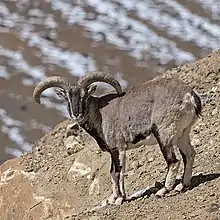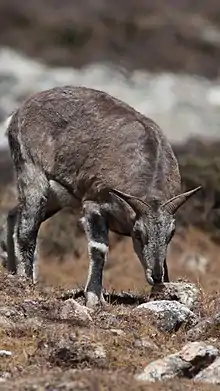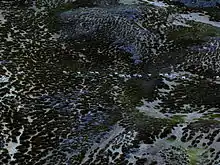Bharal
The bharal (Pseudois nayaur), also called the blue sheep, is a caprid native to the high Himalayas; it occurs in India, Bhutan, Gansu, Inner Mongolia, Myanmar, Nepal, Ningxia, Pakistan, Sichuan, and Tibet.[1] The Helan Mountains of Ningxia have the highest concentration of bharal in the world, with 15 bharals per km2 and 30,000 in total.
| Bharal | |
|---|---|
 | |
| Male bharal in Spiti Valley | |
 | |
| Female bharal in North Sikkim | |
| Scientific classification | |
| Kingdom: | Animalia |
| Phylum: | Chordata |
| Class: | Mammalia |
| Order: | Artiodactyla |
| Family: | Bovidae |
| Subfamily: | Caprinae |
| Genus: | Pseudois |
| Species: | P. nayaur |
| Binomial name | |
| Pseudois nayaur Hodgson, 1833 | |
Its native names include yanyang (岩羊) in Mandarin, bharal, barhal, bharar, and bharut in Hindi, na or sna in Tibetan and Ladakh, nabo in Spitian, naur in Nepali and na or gnao in Bhutan.[2] The bharal was also the focus of George Schaller and Peter Matthiessen's expedition to Nepal in 1973. Their personal experiences are well documented by Matthiessen in his book, The Snow Leopard. The bharal is a major prey of the snow leopard.
Description
These medium-sized caprids are 115 to 165 cm (45 to 65 in) long along the head-and-body, with a tail of 10 to 20 cm (3.9 to 7.9 in). They stand 69 to 91 cm (27 to 36 in) high at the shoulder. Body mass can range from 35 to 75 kg (77 to 165 lb). Males are slightly larger than females. Dense coat is slate grey in colour, sometimes with a bluish sheen. The underparts and backs of the legs are white, while the chest and fronts of the legs are black. Separating the grey back and white belly is a charcoal-colored stripe. The ears are small, and the bridge of the nose is dark. The horns are found in both sexes and are ridged on the upper surface. In males, they grow upwards, then turn sideways and curve backward, looking somewhat like an upside-down mustache. They may grow to a length of 80 cm (31 in). In females, the horns are much shorter and straighter, growing up to 20 cm (7.9 in) long.[3][4]
Taxonomy and evolution
- Chinese blue sheep, Pseudois nayaur szechuanensis
- Himalayan blue sheep, P. n. nayaur
- Helan Shan blue sheep, P. n. ssp.
- Dwarf blue sheep, P. schaeferi, sometimes considered to be a subspecies of the bharal
Behaviour and ecology


.JPG.webp)
Bharal are active throughout the day, alternating between feeding and resting on the grassy mountain slopes. Due to their excellent camouflage and the absence of cover in their environment, bharal remain motionless when approached. Once they have been noticed, however, they scamper up to the precipitous cliffs, where they once again freeze, using camouflage to blend into the rock face. Population densities in Nepal were found to be 0.9–2.7 animals per km2, increasing to a maximum of 10 animals in the winter, as herds congregate in valleys.[3] Bharal are mainly grazers, but during times of scarcity of grass, they switch to browsers, eating herbs and shrubs.[5] A high degree of diet overlap between livestock (especially donkeys) and bharal, together with density-dependent forage limitation, results in resource competition and a decline in bharal density.[6] Where they overlap, they are the favored prey of snow leopards, Himalayan wolves, and leopards, with a few lambs falling prey to foxes or eagles.[3]
Threats
The bharal is categorised as least concern by the International Union for Conservation of Nature and Natural Resources. The population faces threats - poaching for meat and competition with livestock. Poaching, however, is uncommon due to the unsuitable conditions of its habitat. Similarly, livestock do not generally frequent the mountainous regions where bharal occur; even if they do coexist, no notable detrimental effect on the bharal has been observed.[1]
Relationship with humans
Many Buddhist monasteries protect the bharal found around them, but lately, issues of crop damage caused by bharal have started to arise in areas such as the Spiti Valley.
References
- Harris, R.B. (2014). "Pseudois nayaur". IUCN Red List of Threatened Species. 2014: e.T61513537A64313015.
- Lydekker, R. (1900). The great and small game of India, Burma and Tibet, p 93,
- Bharal, Himalayan blue sheep Archived 2015-04-06 at the Wayback Machine. Ultimateungulate.com. Retrieved on 2012-08-23.
- Smith, A. T., Xie, Y. (eds.) (2008) A Guide to the Mammals of China. Princeton University Press, Princeton Oxfordshire ISBN 0691099847.
- Suryawanshi, K.; Bhatnagar, Y.V.; Mishra, C. (2010). "Why Should a Grazer Browse? Livestock impact on winter resource use by bharal Pseudois nayaur". Oecologia. 162 (2): 453–462. doi:10.1007/s00442-009-1467-x. PMID 19784849.
- Mishra, C.; Van Wieren, S. E.; Ketner, Pieter; Heitkonig, Ignas M. A.; Prins, Herbert H. T. (2004). "Competition between domestic livestock and wild bharal Pseudois nayaur in the Indian Trans-Himalaya" (PDF). Journal of Applied Ecology. 41 (2): 344–354. doi:10.1111/j.0021-8901.2004.00885.x. Archived from the original (PDF) on 2011-07-27.
- Lovari, Sandro; Som Ale (2001). "Are there multiple mating strategies in the blue sheep?". Behavioural Processes. 53 (1–2): 131–135. doi:10.1016/S0376-6357(00)00134-0. PMID 11255000.
Further reading
- Namgail, T., Fox, J.L. & Bhatnagar, Y.V. (2004). Habitat segregation between sympatric Tibetan argali Ovis ammon hodgsoni and blue sheep Pseudois nayaur in the Indian Trans-Himalaya. Journal of Zoology (London), 262: 57–63
- Namgail, T., van Wieren, S.E., Mishra, C. & Prins, H.H.T. (2010). Multi-spatial co-distribution of the endangered Ladakh urial and blue sheep in the arid Trans-Himalayan Mountains. Journal of Arid Environments, 74:1162-1169.
- Namgail, T., Mishra, C., de Jong, C. B., van Wieren, S.E. & Prins, H.H.T. (2009). Effects of herbivore species richness on blue sheep niche dynamics and distribution in the Indian Trans-Himalaya. Diversity and Distributions, 15:940-947.
- Namgail, T. (2001). Habitat Selection and Ecological Separation Between Sympatric Tibetan Argali Blue Sheep in Northern India. University of Tromso, Norway.
- Namgail, T. (2006). Winter Habitat Partitioning between Asiatic Ibex and Blue Sheep in Ladakh, Northern India. Journal of Mountain Ecology, 8: 7–13.
- Shrestha, R. & Wegge, P. (2008). Wild sheep and livestock in Nepal Trans-Himalaya: co-existence or competition? Environmental Conservation, 35: 125 – 136.
- Shrestha, R. & Wegge, P. (2008). Habitat relationships between wild and domestic herbivores in Nepalese trans – Himalaya. Journal of Arid Environments, 72: 914–925.
- Shrestha, R., Wegge, P. & Koirala, R. A. (2005). Summer diets of wild and domestic ungulates in Nepal Himalaya. Journal of Zoology (London), 266: 111 – 119.
External links
 Media related to bharal at Wikimedia Commons
Media related to bharal at Wikimedia Commons- Photos and further information
- Bharal at Animal Diversity Web


